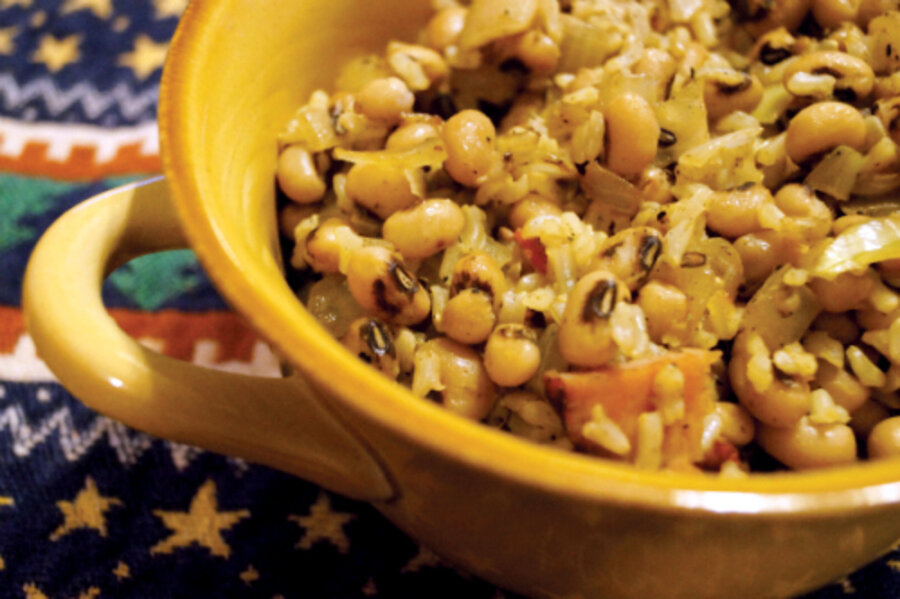Black-eyed peas: Hoppin' John for New Year's Day
Loading...
Living in the North for most of my life I really didn’t encounter the tradition of eating black-eyed peas for New Year's Day until I started following The Runaway Spoon, a food blogger living in Memphis, Tenn. Perre feels very strongly that one must eat black-eyed peas on New Year’s Day to bring good fortune for the coming year.
I always like these hopeful outlooks on the New Year. It is as if we are saying, “That last year was rough. Let’s do this new one right, people!”
Hoppin’ John is a fortifying dish that’s perfect for a northern tradition, too, with its frigid January days, and easy enough to give you a much welcome break from more complicated holiday meals.
Like most food traditions the lineage and history of Hoppin’ John is not that clear. It’s been traced to Southern slave traditions, Southern Jewish traditions, sometimes involves a buried coin (the person who bites the coin will draw riches), collared greens, and cornbread. I’ll leave you to search the interwebs to satisfy your curiosity.
Nathalie Dupree and Cynthia Graubart offer their own explanation in their excellent cookbook “Mastering the Art of Southern Cooking“:
“The black-eyed pea isn’t really a pea at all; it’s a bean. Be that as it may, black-eyed peas are served all year long but with special emphasis to bring luck on New Year’s Day. Combined with an equal amount of cooked rice, they make a traditional African dish, now called Hoppin’ John, and form a complete protein – a vital source of food for what President Franklin D. Roosevelt called ‘the shoeless South’ during the Depression and other hard times.”
Many Hoppin’ John recipes begin with a pot of dried black-eyed peas, soaked and cooked a long time with pork fatback. Living in the fast-paced North, and not finding any dried black-eyed peas or fatback at my local market, I opted for the canned version, which Nathalie and Cynthia say is totally acceptable.
I experimented with pork loin bacon and a few slices of pork salt cooked in with the onions to try and recreate that flavor-infused slow-cooked version. But really, all you need is a few slices of regular bacon. I had some leftover cooked rice on hand, so this came together really fast.
Happy New Year!
Hoppin’ John, quick version
Serves 2
1 15-ounce can black-eyed peas, drained
2-3 slices bacon
1/2 hot red pepper, diced
1/2 medium onion, chopped
1 cup cooked rice
Freshly ground pepper, to taste
Salt, to taste
Optional: salt pork
1. Open can of black-eyed peas, drain, set aside.
2. Over medium high heat, cook bacon 3 minutes per side. Remove from pan. When cool cut into bite-sized pieces.
3. Dice the pepper and and chop the onion. Add the pepper and onion to the bacon drippings in the pan and reduce heat, cook through until onions are translucent. (If you are adding salt pork, add it to the onions and pepper. You won't need to add more salt to this version!)
4. Add the black-eyed peas, cooked rice, and bacon to the pan and combine, stirring until heated through. Salt and pepper to taste. Serve in bowls.
Hoppin’ John
From “Mastering the Art of Southern Cooking” by Nathalie Dupree and Cynthia Graubart
“Traditionally, since this was a New Year’s dish, the peas were dried, but of course, canned or frozen are substituted and seen nearly all year long.”
Serves 6 to 8
2 cups dried black-eyed peas, lady peas, or cowpeas
1 piece fatback, hog jowl, or other smoked meat, slashed in several places
1 hot red pepper
1 medium onion, chopped
Salt
Freshly ground black pepper
1 cup uncooked rice
4 tablespoons drippings, preferably bacon
1. Pour boiling water over the dried peas in a large pot and set aside while preparing other ingredients. When ready to proceed, drain the peas and discard the water.
2. Add fresh water to the peas. Add the fatback, hot red pepper, onion, salt, and black pepper. Bring to the boil; cover reduce heat and simmer until the peas are nearly tender; about 45 minutes to 1 hour, skimming off the foam as needed. Add more water as needed.
3. Continue cooking, covered, until the peas are tender. Remove the peas with a slotted spoon, reserving enough liquid in the pot (about 3 cups) to cook the rice.
4. Bring reserved liquid to the boil, add the rice, and return to the boil; cover. Reduce heat and simmer until the rice is cooked, about 30 minutes.
5. Return peas to the pot, stir together, and cook for a few minutes more. Add drippings to flavor the dish, taste, and adjust seasonings. Turn out into a large dish and serve. This may be made into a tasty salad at a later time.
Variations: Add cooked, frozen, or drained canned black-eyed or crowder peas, and cooked bacon to cooked rice and heat together.
Related post on Kitchen Report: Three Kinds of Fondue (cheese, oil, chocolate)






